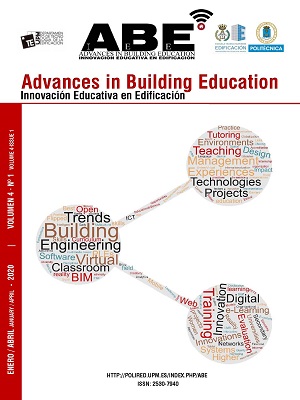Peer-review to promote learning and collaboration between students of “Energy in Buildings” = Evaluación por pares para incentivar el aprendizaje y colaboración entre estudiantes de “Energía en la Edificación”
DOI:
https://doi.org/10.20868/abe.2020.1.4413Keywords:
Project-based assessment, Workshop activity, Moodle platform, Rubric, Evaluación basada en proyectos, Actividad de taller, Plataforma Moodle, Rúbrica.Abstract
Abstract
In educational settings, peer assessment is defined as the process of considering the level, value, worth, quality or success of the outcomes of learning by classmates with the same status (i.e. peers). In the framework of an educational innovation project at Universidad Carlos III de Madrid (UC3M), peer assessment has been implemented during two years in the course of “Energy in Buildings”. In this subject, students individually develop their own project, mainly based on software tools, and apply the knowledge and skills learned within the course. The goal of peer assessment in this course is, not so much to increase student’s marks, but to increase their learning outcomes. The resulting classroom setting also allows a smoother transition to real-life professional settings and the development of interpersonal skills with future co-workers. A learning management system was utilized: Aula Global, virtual platform for students at UC3M, that is based on Moodle. Peer assessment was enabled by using the workshop activity in Moodle platform. To guide the assessment by the students, rubric templates were generated in the same virtual platform. This paper presents the lessons learned during the last year of application of peer assessment in “Energy in Buildings” course.
Resumen
En entornos educativos, la evaluación por pares se define como el proceso de considerar el nivel, valor y calidad o éxito de los resultados de aprendizaje por parte de los propios compañeros (i.e. pares o iguales). En el marco de un proyecto de innovación docente de la Universidad Carlos III de Madrid (UC3M), la evaluación por pares se ha implementado durante dos años en la asignatura ”Energía en la Edificación”. En ella, los estudiantes desarrollan de forma individual su propio proyecto, fundamentalmente basado en herramientas informáticas, y aplican los conocimientos y destrezas que adquieren a lo largo del curso. El objetivo de la revisión por pares en esta asignatura es incrementar, no tanto las calificaciones de los alumnos, sino más bien los resultados de aprendizaje. El entorno de clase resultante permite además una transición más suave hacia la realidad profesional y el desarrollo de habilidades interpersonales con futuros compañeros de trabajo. Se utilizó un sistema de gestión de aprendizaje: Aula Global, plataforma virtual para estudiantes de la UC3M, la cual se basa en Moodle. La evaluación por pares se habilitó mediante la actividad de taller en la plataforma Moodle. Para guiar la evaluación por parte de los estudiantes, se generaron plantillas de rúbrica en la propia plataforma virtual. Este trabajo presenta las lecciones aprendidas durante el último año de aplicación de la revisión por pares en la asignatura de “Energía en la Edificación”.
Downloads
References
K. Topping, “Peer Assessment between Students in Colleges and Universities,” Rev. Educ. Res., vol. 68, no. 3, p. 249, 1998, doi:10.2307/1170598.
C. Adachi, J. H.-M. Tai, and P. Dawson,“Academics’ perceptions of the benefits and challenges of self and peer assessment in higher education,” Assess. Eval. High. Educ., vol. 43, no. 2, pp. 294–306, 2018.
R. M. Crespo-García and J. VillenaRomán, “Revisión entre pares como instrumento de aprendizaje: Una experiencia práctica, Serie de Innovación Docente No. 05-03-01-2005,” 2005. doi: earchivo.uc3m.es/handle/10016/604.
C. Dominguez, M. Nascimento, A. Maia, D. Pedrosa, and G. Cruz, “Come together: peer review with energy engineering students,” Int. J. Eng. Pedagog., vol. 4, no. 5, pp. 34–41, 2014.
M. A. Rodríguez Esteban, M. A. FrechillaAlonso, and M. P. Saez-Pérez, “Implementación de la evaluación por pares como herramienta de aprendizaje en grupos numerosos. Experiencia docente entre universidades = Implementation of the evaluation by pairs as a learning tool in large groups. Teaching experience between universities,” Adv. Build. Educ., vol. 2, no. 1, p. 66, Apr. 2018, doi: 10.20868/abe.2018.1.3694.
UC3M, “‘Energy in Buildings’ course program,” 2020. https://aplicaciones.uc3m.es/cpa/generaFicha?est=280&asig=16846&idioma=2.
Moodle, “Workshop activity,” Documentation (version 3.5). https://docs.moodle.org/35/en/Workshop_activity.
A. ArchMiller, J. Fieberg, J. D. Walker and N. Holm, “Group peer assessment for summative evaluation in a graduate-level statistics course for ecologists,” Assess. Eval. High. Educ., vol. 42, no. 8, pp. 1208–1220, 2017.
D. Amendola and C. Miceli, “Online peer assessment to improve students’ learning outcomes and soft skills,” Ital. J. Educ. Technol., vol. 26, no. 3, pp. 71–84, 2018.
V. I. Marín and A. Pérez Garcias, “Collaborative e-Assessment as a Strategy for Scaffolding Self-Regulated Learning in Higher Education,” in Formative Assessment, Learning Data Analytics and Gamification, Elsevier, 2016, pp. 3–24.
ASHRAE, “Standard 90.1 Energy standard for buildings except low rise residential buildings.”
“Código Técnico de la Edificación. Documento Básico HE (Ahorro de energía),” 2013. [Online]. Available: https://www.codigotecnico.org/index.php/menu-ahorro-energia.html.
EU, “Energy Performance of Buildings Directive (EPBD).” [Online]. Available: https://eur-lex.europa.eu/legalcontent/EN/TXT/HTML/?uri=CELEX:32010L0031&from=EN.
Moodle, “Using Workshop,” Documentation (version 3.5). https://docs.moodle.org/35/en/Using_Workshop.
Moodle, “Workshop settings,” Documentation (version 3.5). https://docs.moodle.org/35/en/Workshop_settings
Downloads
Published
Issue
Section
License
ABE (Advances in Building Education / Innovación Educativa en Edificación) does not charge authors for processing or publishing an article and provides immediate Open Access to its content. All content is available free of charge to the user or his institution. Users are permitted to read, download, copy, distribute, print, search or link to the full text of articles, or use them for any other lawful purpose, without prior permission from the publisher or author. This is in accordance with the BOAI definition of open access.
- Authors retain the copyright and grant to the journal the right to a Creative Commons attribution / Non-Commercial / Non-Derivative 4.0 International (CC BY NC ND) License that allows others to share the work with an acknowledgement of authorship and non-commercial use.
- Authors may separately establish additional agreements for the non-exclusive distribution of the version of the work published in the journal (for example, placing it in an institutional repository or publishing it in a book).
Unless otherwise indicated, all contents of the electronic edition are distributed under a Creative Commons license.














